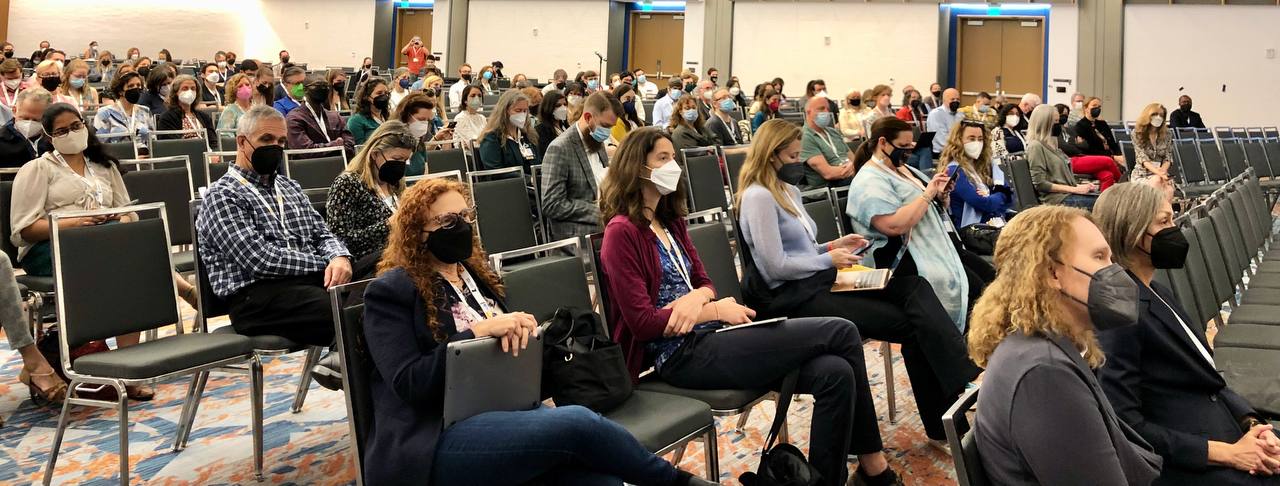
We are not yet done with COVID-19’s origin, journalists say
Journalist Jane Qiu (left) shared her experience of reporting on the SARS-CoV-2 origin story during the opening plenary at ScienceWriters2022. Also shown are moderator Deborah Blum (at lectern) and panelist Jon Cohen. (Photo by Saugat Bolakhe)
About 70% of the world’s population has been vaccinated with at least a first dose of COVID-19 vaccine. But nearly three years after the start of the pandemic, a fundamental concern still lurks in many minds.
“We don’t have all the answers as to how, exactly, this pandemic originated,” noted Deborah Blum, director of the Knight Science Journalism Program at MIT, who moderated a session where journalists and a history scholar discussed media coverage of the controversy over the origin of the SARS-CoV-2 virus Oct. 22 at the ScienceWriters2022 conference in Memphis, Tenn.
Blum asked Jon Cohen, senior correspondent at Science, his perspective on why so many people care about the origin of the virus. “This affected the world,” Cohen said. “And we like to think that we can control our lives and stop really bad things from happening if we understand why they happen.” He added, “We love to try to understand where we came from, and why anything begins.”

Part of the reason the origin story turned into something so controversial is because of China and its policies, said Katherine Eban, contributing editor at Vanity Fair. Because of the governmental policies, international researchers and investigators “do not have full information. We do not have underlying data. We do not have laboratory notebooks,” she said. And the fact that the government is not willing to comply with international investigation has also fueled “a sense of mystery.”
Panelists also discussed in detail an origin theory that has been disseminated widely in opposition to the theory, supported by most investigations that have been done to date, that the virus spread among humans following human-animal contact in a Wuhan market.
The “lab leak” theory alleges that the virus may have been created at the Wuhan Institute of Virology or escaped while scientists were studying it there. The source of this theory could be deeply ingrained in the human psyche, Cohen said. Humans by nature are inclined to speculate on controversies, myths, and political agendas. These elements add spice to a larger social conversation that we are evolutionarily geared toward, he said.
Also, the fact that the lab-origin story initially wasn’t treated as a legitimate question and got marked as a conspiracy theory “has colored not just how the question of origins has played out but also the way in which the answers have unfolded,” said J. Benjamin Hurlbut, a historian at Arizona State University. Hurlbut also noted that in this process larger social discussion around it became so hot that it ended up dividing societies and turning them unnecessarily toxic.
According to Jane Qiu, a Beijing-based freelance science writer, the way journalists approach reporting on origin stories may have also colored their coverage. She added that issues of such global significance weigh on journalists and investigators. While reporting on a story with such a huge political angle, there were moments when she started to doubt her own abilities. While searching for the answers, she said, “I was worried about whether I could be objective, whether I would be affected by my own sentiment.”
Journalists should also be careful when making assumptions about other parts of the world, she added. Qiu, who became known for her extensive access to scientists in Wuhan, suggested that when reporting on controversial topics, writers should find ways to build trust with researchers. Science writers bear some responsibility for how their stories are interpreted around the world if they do not provide full context, she said. This can lead to more controversies and social divisions.